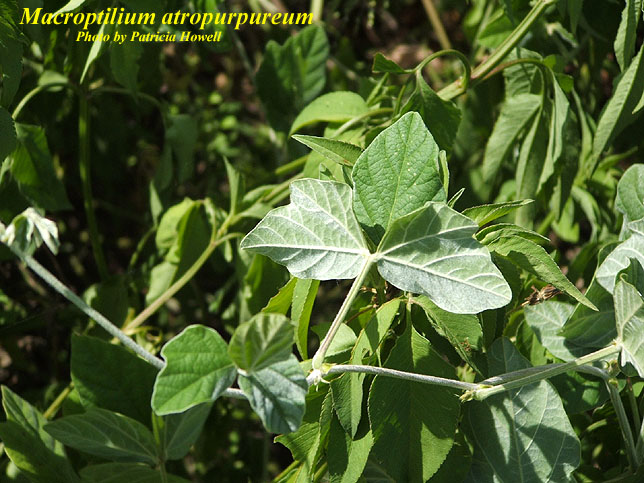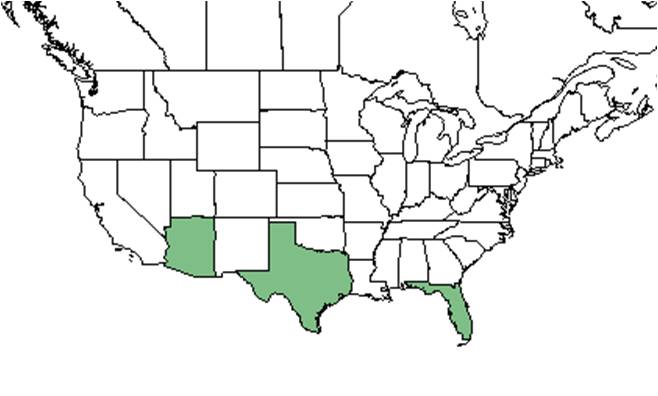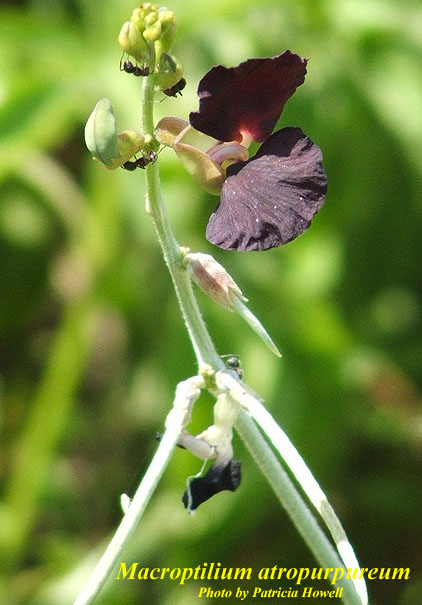Difference between revisions of "Macroptilium atropurpureum"
(Created page with "{{italic title}} <!-- Get the taxonomy information from the NRCS Plants database --> {{taxobox | name = Macroptilium atropurpureum | image = Insert.jpg | image_caption = | re...") |
HaleighJoM (talk | contribs) (→Ecology) |
||
| (43 intermediate revisions by 7 users not shown) | |||
| Line 3: | Line 3: | ||
{{taxobox | {{taxobox | ||
| name = Macroptilium atropurpureum | | name = Macroptilium atropurpureum | ||
| − | | image = | + | | image = Macr_atro.jpg |
| − | | image_caption = | + | | image_caption = Photo by Patricia Howell, [http://www.florida.plantatlas.usf.edu/Default.aspx Atlas of Florida Vascular Plants] |
| regnum = Plantae | | regnum = Plantae | ||
| divisio = Magnoliophyta - Flowering plants | | divisio = Magnoliophyta - Flowering plants | ||
| classis = Magnoliopsida – Dicotyledons | | classis = Magnoliopsida – Dicotyledons | ||
| ordo = Ericales | | ordo = Ericales | ||
| − | | familia = | + | | familia = Fabaceae |
| genus = ''Macroptilium '' | | genus = ''Macroptilium '' | ||
| species = '''''M. atropurpureum''''' | | species = '''''M. atropurpureum''''' | ||
| binomial = ''Macroptilium atropurpureum'' | | binomial = ''Macroptilium atropurpureum'' | ||
| binomial_authority = (Lam.) K. Koch | | binomial_authority = (Lam.) K. Koch | ||
| − | | range_map = | + | | range_map = macr_atro_dist.jpg |
| − | | range_map_caption = Natural range of ''Macroptilium atropurpureum'' from USDA NRCS [http:// | + | | range_map_caption = Natural range of ''Macroptilium atropurpureum'' from USDA NRCS [http://plants.usda.gov/core/profile?symbol=MAAT80 Plants Database]. |
}} | }} | ||
| + | |||
| + | Common name: Purple bushbean | ||
| + | ==Taxonomic notes== | ||
| + | Synonym: ''Phaseolus atropurpureus'' Moc. & Sessé ex DC. [http://plants.usda.gov/core/profile?symbol=MAAT80 USDA NRCS Plants Database] | ||
| + | |||
==Description== | ==Description== | ||
<!-- Basic life history facts such as annual/perrenial, monoecious/dioecious, root morphology, seed type, etc. --> | <!-- Basic life history facts such as annual/perrenial, monoecious/dioecious, root morphology, seed type, etc. --> | ||
| − | + | A perennial species in tropical regions and an annual in subtropical climates. It is a trailing, climbing, twining species with a deep, swollen taproot. <ref name="Morris 2010">Morris, J. B. (2010). "Morphological, pheological and reproductive trait analysis for the pasture species, siratro (Macroptilium atropurpureum)." Tropical Grasslands 44: 266-273.</ref> | |
| + | |||
==Distribution== | ==Distribution== | ||
| + | It is a native to tropical continental America, and is distributed through out the tropics.<ref name="eol">[[http://eol.org/pages/644780/details]] Encyclopedia of Life Accessed: February 10, 2016</ref> | ||
| + | |||
==Ecology== | ==Ecology== | ||
===Habitat=== <!--Natural communities, human disturbed habitats, topography, hydrology, soils, light, fire regime requirements for removal of competition, etc.--> | ===Habitat=== <!--Natural communities, human disturbed habitats, topography, hydrology, soils, light, fire regime requirements for removal of competition, etc.--> | ||
| + | Habitats include disturbed ruderal areas such as lawns, along railroad beds, and pastures. <ref name="FSU Herbarium">Florida State University Robert K. Godfrey Herbarium database. URL: [http://herbarium.bio.fsu.edu http://herbarium.bio.fsu.edu]. Last accessed: February 2016. Collectors: Loran C. Anderson. States and Counties: Florida: Clay, Escambia, Leon, Nassau, Osceola, Putname. Countries: Honduras. Compiled by Tall Timbers Research Station and Land Conservancy.</ref> It has great economic importance in cover crop, forage and prevents soil erosion. <ref name="Cook et al. 2005">Cook, B.G., Pengelly, B.C., Brown, S.D., Donnelly, J.L., EAgles, D.A., Franco, M.A. Hanosn, J., Mullen, B.F., Partridge, I.J. Peters, M., Shultze-Kraft, R. (2005). "Tropical forages: An interactive selection tool." CD-ROM. CSIRO, DPI&F (Queensland), CIAT and ILRI.</ref> A long, deep taproot and the ability to reduce evapotranspiration by shedding its leaves allows for tolerance of dry conditions.<ref name="feedipedia">[[http://www.feedipedia.org/node/278]] Feedipedia Accessed: February 10, 2016</ref> | ||
| + | |||
| + | ''M. atropurpureum'' can be nodulated by a range of alpha-rhizobial strains, which allow for nitrogen-fixation and allows the plants to thrive in nutrient poor soils. Soil, pH, phosphate, and CaCO3 content and granulation influence the type of rhizobial nodulation that occurs. When ''M. atropurpureum'' grows under dry, high temperature conditions, ''Burkholderia tuberum'' induces nitrogen fixing nodules. <ref name="Angus et al. 2013">Angus, A. A., A. Lee, et al. (2013). "Nodulation and effective nitrogen fixation of Macroptilium atropurpureum (siratro) by Burkholderia tuberum, a nodulating and plant growth promoting beta-proteobacterium, are influenced by environmental factors." Plant and Soil 369(1): 543-562.</ref> | ||
| + | |||
===Phenology=== <!--Timing off flowering, fruiting, seed dispersal, and environmental triggers. Cite PanFlora website if appropriate: http://www.gilnelson.com/PanFlora/ --> | ===Phenology=== <!--Timing off flowering, fruiting, seed dispersal, and environmental triggers. Cite PanFlora website if appropriate: http://www.gilnelson.com/PanFlora/ --> | ||
| − | ===Seed dispersal=== | + | Flowers and fruits August through October. <ref name="FSU Herbarium"/> It has been observed that flowering is initiated in response to the onset of dry periods and shorter days while vegetative growth resumes with the return of moist conditions.<ref name="tropical">[[http://www.tropicalforages.info/key/Forages/Media/Html/Macroptilium_atropurpureum.htm]] Tropical Forages Accessed: February 10, 2016</ref> |
| + | |||
| + | In subtropical climates, it displays an annual lifecycle, while in tropical climate is perennial. Perennation of this species has been observed to be associated with survival of the original crowns that develop from seedlings. Individuals that are produced by vegetative reproduction from rooted stolons, are short lived and only survive until the end of the wet season. <ref name="Gutteridge 1985">Gutteridge, R. C. (1985). "Survival and Regeneration of Four Legumes Oversown into Native Grasslands in Northeast Thailand." Journal of Applied Ecology 22(3): 885-894.</ref> | ||
| + | <!--===Seed dispersal===--> | ||
===Seed bank and germination=== | ===Seed bank and germination=== | ||
| + | Seed reserves are important for individual replacement in subtropical conditions where the species displays an annual lifecycle. <ref name="Gutteridge 1985"/> | ||
| + | |||
===Fire ecology=== <!--Fire tolerance, fire dependence, adaptive fire responses--> | ===Fire ecology=== <!--Fire tolerance, fire dependence, adaptive fire responses--> | ||
| − | ===Pollination=== | + | Post-fire, plants recover well from crowns or stems if perennial and soil seed reserves if annual.<ref name="tropical"/> |
| − | === | + | |
| + | <!--===Pollination===--> | ||
| + | ===Herbivory and toxicology=== <!--Common herbivores, granivory, insect hosting, poisonous chemicals, allelopathy, etc.--> | ||
| + | ''Macroptilium atropurpureum'' was observed at the Archbold Biological Station to host bees from the Apidae family such as ''Apis mellifera'' and leafcutting bees from the Megachille family such as ''Megachile georgica''.<ref name="Deyrup 2015">Deyrup, M.A. and N.D. 2015. Database of observations of Hymenoptera visitations to flowers of plants on Archbold Biological Station, Florida, USA.</ref> | ||
| + | |||
===Diseases and parasites=== | ===Diseases and parasites=== | ||
| − | ==Conservation and | + | This species is susceptible to a variety of diseases and viruses. Under conditions of high rainfall and high humidity, ''Rhizoctonia solani'' causes foliar blight that can reduce leaf yields by 80%; however, plants can recover with a return to dry conditions. ''Synchytrium phaseoli'', false rust, occurs during periods of high humidity. Viruses include mung bean yellow mosaic virus and passionfruit woodiness potyvirus.<ref name="tropical"/> |
| − | == | + | |
| + | ==Conservation, cultivation, and restoration== | ||
| + | ''M. atropurpureum'' is of economic importance for forage, cover crop and preventing soil erosion. <ref name="Cook et al. 2005"/> It has been observed to thrive in light stocking and/or rotational grazing. Regular heavy grazing causes loss of buds, shorter plant growth, reduced seed set, and declining soil seed reserves<ref name="tropical"/>. | ||
| + | |||
| + | ==Cultural use== | ||
| + | |||
==Photo Gallery== | ==Photo Gallery== | ||
| + | <gallery widths=180px> | ||
| + | File: Macr_atro-PHl_Bloom.jpg | <center> Flowers of ''Macroptilium'' ''atropurpureum'' <p> Photo by Patricia Howell, [http://www.florida.plantatlas.usf.edu/Default.aspx Atlas of Florida Vascular Plants] </p> | ||
| + | </gallery> | ||
| + | |||
==References and notes== | ==References and notes== | ||
| + | |||
| + | |||
| + | Calles, T., G. P. Lewis, et al. (2015). "Lectotypification of Macroptilium atropurpureum (Leguminosae)." Kew Bulletin 70(1). | ||
Latest revision as of 19:20, 14 July 2022
| Macroptilium atropurpureum | |
|---|---|

| |
| Photo by Patricia Howell, Atlas of Florida Vascular Plants | |
| Scientific classification | |
| Kingdom: | Plantae |
| Division: | Magnoliophyta - Flowering plants |
| Class: | Magnoliopsida – Dicotyledons |
| Order: | Ericales |
| Family: | Fabaceae |
| Genus: | Macroptilium |
| Species: | M. atropurpureum |
| Binomial name | |
| Macroptilium atropurpureum (Lam.) K. Koch | |

| |
| Natural range of Macroptilium atropurpureum from USDA NRCS Plants Database. | |
Common name: Purple bushbean
Contents
Taxonomic notes
Synonym: Phaseolus atropurpureus Moc. & Sessé ex DC. USDA NRCS Plants Database
Description
A perennial species in tropical regions and an annual in subtropical climates. It is a trailing, climbing, twining species with a deep, swollen taproot. [1]
Distribution
It is a native to tropical continental America, and is distributed through out the tropics.[2]
Ecology
Habitat
Habitats include disturbed ruderal areas such as lawns, along railroad beds, and pastures. [3] It has great economic importance in cover crop, forage and prevents soil erosion. [4] A long, deep taproot and the ability to reduce evapotranspiration by shedding its leaves allows for tolerance of dry conditions.[5]
M. atropurpureum can be nodulated by a range of alpha-rhizobial strains, which allow for nitrogen-fixation and allows the plants to thrive in nutrient poor soils. Soil, pH, phosphate, and CaCO3 content and granulation influence the type of rhizobial nodulation that occurs. When M. atropurpureum grows under dry, high temperature conditions, Burkholderia tuberum induces nitrogen fixing nodules. [6]
Phenology
Flowers and fruits August through October. [3] It has been observed that flowering is initiated in response to the onset of dry periods and shorter days while vegetative growth resumes with the return of moist conditions.[7]
In subtropical climates, it displays an annual lifecycle, while in tropical climate is perennial. Perennation of this species has been observed to be associated with survival of the original crowns that develop from seedlings. Individuals that are produced by vegetative reproduction from rooted stolons, are short lived and only survive until the end of the wet season. [8]
Seed bank and germination
Seed reserves are important for individual replacement in subtropical conditions where the species displays an annual lifecycle. [8]
Fire ecology
Post-fire, plants recover well from crowns or stems if perennial and soil seed reserves if annual.[7]
Herbivory and toxicology
Macroptilium atropurpureum was observed at the Archbold Biological Station to host bees from the Apidae family such as Apis mellifera and leafcutting bees from the Megachille family such as Megachile georgica.[9]
Diseases and parasites
This species is susceptible to a variety of diseases and viruses. Under conditions of high rainfall and high humidity, Rhizoctonia solani causes foliar blight that can reduce leaf yields by 80%; however, plants can recover with a return to dry conditions. Synchytrium phaseoli, false rust, occurs during periods of high humidity. Viruses include mung bean yellow mosaic virus and passionfruit woodiness potyvirus.[7]
Conservation, cultivation, and restoration
M. atropurpureum is of economic importance for forage, cover crop and preventing soil erosion. [4] It has been observed to thrive in light stocking and/or rotational grazing. Regular heavy grazing causes loss of buds, shorter plant growth, reduced seed set, and declining soil seed reserves[7].
Cultural use
Photo Gallery
Flowers of Macroptilium atropurpureum Photo by Patricia Howell, Atlas of Florida Vascular Plants
References and notes
Calles, T., G. P. Lewis, et al. (2015). "Lectotypification of Macroptilium atropurpureum (Leguminosae)." Kew Bulletin 70(1).
- ↑ Morris, J. B. (2010). "Morphological, pheological and reproductive trait analysis for the pasture species, siratro (Macroptilium atropurpureum)." Tropical Grasslands 44: 266-273.
- ↑ [[1]] Encyclopedia of Life Accessed: February 10, 2016
- ↑ 3.0 3.1 Florida State University Robert K. Godfrey Herbarium database. URL: http://herbarium.bio.fsu.edu. Last accessed: February 2016. Collectors: Loran C. Anderson. States and Counties: Florida: Clay, Escambia, Leon, Nassau, Osceola, Putname. Countries: Honduras. Compiled by Tall Timbers Research Station and Land Conservancy.
- ↑ 4.0 4.1 Cook, B.G., Pengelly, B.C., Brown, S.D., Donnelly, J.L., EAgles, D.A., Franco, M.A. Hanosn, J., Mullen, B.F., Partridge, I.J. Peters, M., Shultze-Kraft, R. (2005). "Tropical forages: An interactive selection tool." CD-ROM. CSIRO, DPI&F (Queensland), CIAT and ILRI.
- ↑ [[2]] Feedipedia Accessed: February 10, 2016
- ↑ Angus, A. A., A. Lee, et al. (2013). "Nodulation and effective nitrogen fixation of Macroptilium atropurpureum (siratro) by Burkholderia tuberum, a nodulating and plant growth promoting beta-proteobacterium, are influenced by environmental factors." Plant and Soil 369(1): 543-562.
- ↑ 7.0 7.1 7.2 7.3 [[3]] Tropical Forages Accessed: February 10, 2016
- ↑ 8.0 8.1 Gutteridge, R. C. (1985). "Survival and Regeneration of Four Legumes Oversown into Native Grasslands in Northeast Thailand." Journal of Applied Ecology 22(3): 885-894.
- ↑ Deyrup, M.A. and N.D. 2015. Database of observations of Hymenoptera visitations to flowers of plants on Archbold Biological Station, Florida, USA.
